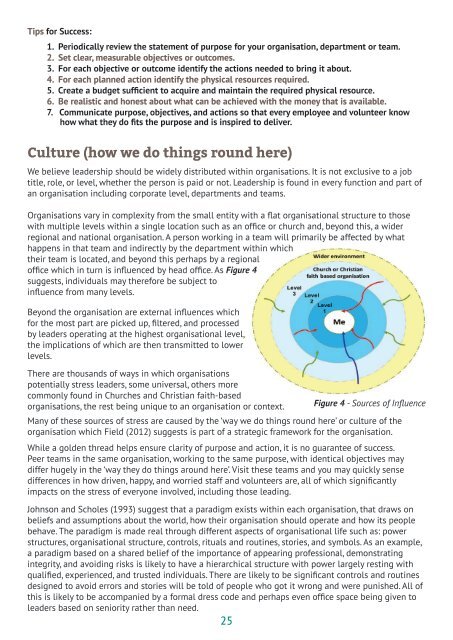Burnout in Churches and Christian Faith-Based Organisations
Burnout is a “syndrome of emotional exhaustion, depersonalization and reduced personal accomplishment that can occur among individuals who work with people in some capacity (Maslach 1996:193). This definition, whilst helpful, fails to convey the potentially life-shattering impact that burnout can have, as described in the words of ‘Peter’, a Christian leader who contributed to this guidance.
Burnout is a “syndrome of emotional exhaustion, depersonalization and reduced personal accomplishment that can occur among individuals who work with people in some capacity (Maslach 1996:193).
This definition, whilst helpful, fails to convey the potentially life-shattering impact that burnout can have, as described in the words of ‘Peter’, a Christian leader who contributed to this guidance.
You also want an ePaper? Increase the reach of your titles
YUMPU automatically turns print PDFs into web optimized ePapers that Google loves.
Tips for Success:<br />
1. Periodically review the statement of purpose for your organisation, department or team.<br />
2. Set clear, measurable objectives or outcomes.<br />
3. For each objective or outcome identify the actions needed to br<strong>in</strong>g it about.<br />
4. For each planned action identify the physical resources required.<br />
5. Create a budget sufficient to acquire <strong>and</strong> ma<strong>in</strong>ta<strong>in</strong> the required physical resource.<br />
6. Be realistic <strong>and</strong> honest about what can be achieved with the money that is available.<br />
7. Communicate purpose, objectives, <strong>and</strong> actions so that every employee <strong>and</strong> volunteer know<br />
how what they do fits the purpose <strong>and</strong> is <strong>in</strong>spired to deliver.<br />
Culture (how we do th<strong>in</strong>gs round here)<br />
We believe leadership should be widely distributed with<strong>in</strong> organisations. It is not exclusive to a job<br />
title, role, or level, whether the person is paid or not. Leadership is found <strong>in</strong> every function <strong>and</strong> part of<br />
an organisation <strong>in</strong>clud<strong>in</strong>g corporate level, departments <strong>and</strong> teams.<br />
<strong>Organisations</strong> vary <strong>in</strong> complexity from the small entity with a flat organisational structure to those<br />
with multiple levels with<strong>in</strong> a s<strong>in</strong>gle location such as an office or church <strong>and</strong>, beyond this, a wider<br />
regional <strong>and</strong> national organisation. A person work<strong>in</strong>g <strong>in</strong> a team will primarily be affected by what<br />
happens <strong>in</strong> that team <strong>and</strong> <strong>in</strong>directly by the department with<strong>in</strong> which<br />
their team is located, <strong>and</strong> beyond this perhaps by a regional<br />
office which <strong>in</strong> turn is <strong>in</strong>fluenced by head office. As Figure 4<br />
suggests, <strong>in</strong>dividuals may therefore be subject to<br />
<strong>in</strong>fluence from many levels.<br />
Beyond the organisation are external <strong>in</strong>fluences which<br />
for the most part are picked up, filtered, <strong>and</strong> processed<br />
by leaders operat<strong>in</strong>g at the highest organisational level,<br />
the implications of which are then transmitted to lower<br />
levels.<br />
There are thous<strong>and</strong>s of ways <strong>in</strong> which organisations<br />
potentially stress leaders, some universal, others more<br />
commonly found <strong>in</strong> <strong>Churches</strong> <strong>and</strong> <strong>Christian</strong> faith-based<br />
organisations, the rest be<strong>in</strong>g unique to an organisation or context.<br />
25<br />
Figure 4 - Sources of Influence<br />
Many of these sources of stress are caused by the ‘way we do th<strong>in</strong>gs round here’ or culture of the<br />
organisation which Field (2012) suggests is part of a strategic framework for the organisation.<br />
While a golden thread helps ensure clarity of purpose <strong>and</strong> action, it is no guarantee of success.<br />
Peer teams <strong>in</strong> the same organisation, work<strong>in</strong>g to the same purpose, with identical objectives may<br />
differ hugely <strong>in</strong> the ‘way they do th<strong>in</strong>gs around here’. Visit these teams <strong>and</strong> you may quickly sense<br />
differences <strong>in</strong> how driven, happy, <strong>and</strong> worried staff <strong>and</strong> volunteers are, all of which significantly<br />
impacts on the stress of everyone <strong>in</strong>volved, <strong>in</strong>clud<strong>in</strong>g those lead<strong>in</strong>g.<br />
Johnson <strong>and</strong> Scholes (1993) suggest that a paradigm exists with<strong>in</strong> each organisation, that draws on<br />
beliefs <strong>and</strong> assumptions about the world, how their organisation should operate <strong>and</strong> how its people<br />
behave. The paradigm is made real through different aspects of organisational life such as: power<br />
structures, organisational structure, controls, rituals <strong>and</strong> rout<strong>in</strong>es, stories, <strong>and</strong> symbols. As an example,<br />
a paradigm based on a shared belief of the importance of appear<strong>in</strong>g professional, demonstrat<strong>in</strong>g<br />
<strong>in</strong>tegrity, <strong>and</strong> avoid<strong>in</strong>g risks is likely to have a hierarchical structure with power largely rest<strong>in</strong>g with<br />
qualified, experienced, <strong>and</strong> trusted <strong>in</strong>dividuals. There are likely to be significant controls <strong>and</strong> rout<strong>in</strong>es<br />
designed to avoid errors <strong>and</strong> stories will be told of people who got it wrong <strong>and</strong> were punished. All of<br />
this is likely to be accompanied by a formal dress code <strong>and</strong> perhaps even office space be<strong>in</strong>g given to<br />
leaders based on seniority rather than need.



